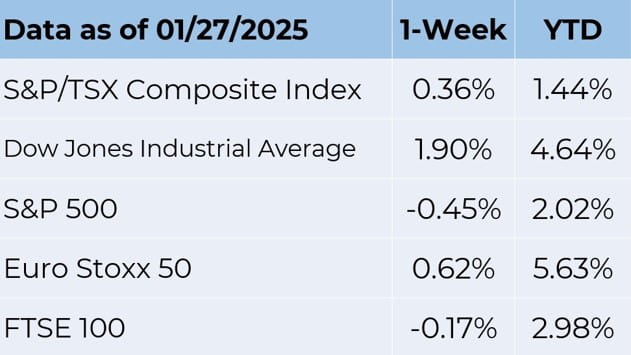Weekly Market Commentary January 30 2025
Canada Economy on Edge
Interest rate cuts are turning out to be the main policy tool that could help steer the Canadian economy into stability at a time when it's facing a string of headwinds. Leadership vacuum with the resignation of Justin Trudeau as the prime minister and President Donald Trump's 25% tariff threat are some of the headwinds keeping the economy and markets on edge.
The Canadian economy avoided recession last year, amid the high interest rate environment, as the Bank of Canada embarked on interest rate cuts. It is highly expected that the BoC will conduct yet another cut on January 29th and provide an analysis of the potential of U.S. tariffs. It will be the first cut since Trump threatened Canada with tariffs.
Trump’s comments have confused many businesses and investors, given that Canada is the U.S.'s biggest trading partner. Both Canadian households and businesses are at significant risk from the growing threat of tariffs. It might impact many people's financial planning and result in higher borrowing costs. A number of households are about to renew their mortgages, so the BoC's decision will have a significant impact. Access to credit for businesses is also likely to be substantial on a larger scale.
The confusion has essentially made BoC’s monetary policy decisions and estimates critical. The benchmark rate will drop to 3.0% if the BoC makes the anticipated cuts. The rate would be lowered by 200 basis points over seven months, marking the bank's sixth straight rate cut since June.
However, most economists think that because tariffs threaten the Canadian economy, it is hard to predict rates past the next meeting. When a 25% tariff is placed on Canada, economists want to see the bank's analysis of the economy, jobs, and inflation. They also want to see what might happen if and when Canada retaliates.
RBC Assistant Chief Economist Nathan Janzen added that the bank would need to make cuts to stimulate the economy and lower unemployment, which is still much higher than the previous year. According to Janzen, the BoC has only been easing off the brakes with cuts thus far. A range of interest rates that would be really stimulative for the economy has not yet been pursued.
Canada's stock market was yet again on the receiving end, after rallying last week on the back of gains in the industrial and utility sectors. The rally last week was mostly driven by the expectation of another wave of interest rate cuts on inflation, finding support below the recommended 2%. Nevertheless, the market gave up most of the gains, as revelations about the Chinese research lab DeepSeek rattled the market.
Canada's main stock index, the Toronto Stock Exchange, was down by 179.34 points to 25,289 at the start of trading on Monday. Internet technology stocks fueled the selloff, following reports that a Chinese company can enable an artificial intelligence model while using cheaper chips at some of the lowest costs. Nevertheless, the market remains in an uptrend, bolstered by an accommodative monetary policy.
The Markets
What moves financial markets? The short answer is: Lots of things!
Almost one hundred years ago, Benjamin Graham and David L. Dodd wrote, “The market is a voting machine, whereon countless individuals register choices which are the product partly of reason and partly of emotion.” Today, the same holds true. Stock prices are influenced by many factors. Here are three examples:
1. Market trends. Last year, companies with strong momentum characteristics—meaning their prices were trending higher— generally did well. “The main rationale behind momentum investing is that once a trend is well-established, it is likely to continue,” reported the Corporate Finance Institute.
The idea may seem contrary to the primary rule of investing, sell high and buy low, but the approach is backed by academic research. It “captures the tendency for market trends to persist for a while, whether it’s because more investors are jumping in or are late to absorb new information,” reported Justina Lee of Bloomberg. As one researcher told Lee, “Momentum investing is great until it’s not.”
2. Investor sentiment. Emotion plays a significant role in stock market volatility. For example, last week, we saw a relief rally. Asian stocks rose and the Standard & Poor’s (S&P) 500 Index hit a new high because the news was less bad than investors had expected. Isabelle Lee, Lu Wang, and Phil Serafino of Bloomberg explained:
“Despite the protectionist threats of the campaign trail, Trump held off on imposing levies on key trading partners this week, and just last night delivered his most mollifying message yet to China by saying that he would rather not have to use tariffs against the world’s second-biggest economy. Cue a relief rally across markets.”
3. Company fundamentals. Graham and Dodd recommended fundamental analysis to identify stocks with good value. Investors who rely on fundamental analysis study companies’ financial statements, and consider assets and liabilities, revenue and expenses, earnings and cash flow, and other factors. Then, they do some math to evaluate the company’s value using various measures like the price-to-earnings ratio. In theory, a company with a low share price relative to its earnings is a good value.
No one knows how markets will perform over the short term. That’s one reason it’s important to hold a diversified portfolio. Owning investments that perform differently in various market conditions helps manage investment risk and may smooth returns over time.
Last week, major U.S. stock indices rose.The S&P 500 moved higher over the week, the Dow Jones Industrial Average gained 2.2%, and the Nasdaq Composite rose 1.7%, reported Paul R. LaMonica of Barron’s. Yields on U.S. Treasuries were relatively steady.

Source: FactSet
PLANNING FOR REQUIRED MINIMUM DISTRIBUTIONS. If you save for retirement in a qualified plan, such as a 401(k) plan or an IRA, the government currently requires you to take withdrawals from these accounts during retirement. The withdrawals, known as required minimum distributions or RMDs, are taxable, so it’s a good idea to plan ahead and avoid unexpected tax consequences.
Here is some basic information about RMDs. It is offered with the caveat that RMDs have complex rules. It’s important to talk with your financial or tax professional before taking action.
If your 73rd birthday is in 2025, your first RMD must be taken by April 1, 2026. Your second RMD should be taken by December 31, 2026, your third RMD by December 31, 2027, and so on.
If you delay your first distribution until April 1, 2026, then you will need to take two RMDs in the same year.
If you have multiple 401(k) plans and IRA accounts, you typically must calculate the RMD for each one of them. You can, however, withdraw the entire amount from a single account.
If you’re still working at age 73, you don’t have to take an RMD from your workplace retirement plan account (as long as the plan allows it). This exception does not apply to traditional IRAs. You must take RMDs from traditional IRAs, even if you’re still working.
If you inherit an IRA from a spouse (after 2019) who already reached age 73, you will normally need to take an RMD for the year of death, if your spouse did not already take one. If your spouse dies before age 73, you may be able to keep the inherited account, roll it over into your IRA, or withdraw the money in a lump sum or over a period of time.
If you inherit an IRA from someone other than your spouse (after 2019), usually the funds must be completely withdrawn from the account within 10 years. RMDs may be required if the person from whom you inherited the account was already taking RMDs.12 There are some exceptions.
If you miss an RMD deadline or you don't withdraw the full amount, penalties are steep. The penalty tax is 25% of the amount you failed to withdraw. If you correct the issue within two years, the penalty tax is lower.
If you own a Roth IRA or Designated Roth account in workplace plan, you do not have to take RMDs—unless you inherited the account. In that case, RMD rules usually apply.
Again, the rules governing RMDs are complex, and calculating RMDs is not always straightforward. If you would like help, or you have questions, please get in touch.
Weekly Focus – Think About It
“Never wear anything that panics the cat.”
—P.J. O’Rourke, comedian
Best regards,
Eric Muir
B.Comm (Hons. Finance), CIM®, FCSI
Senior Portfolio Manager
Derek Lacroix
BBA, CIM®, CFP®
Associate Portfolio Manager

P.S. Please feel free to forward this commentary to family, friends or colleagues. If you would like us to add them to the list, please reply to this email with their email address and we will ask for their permission to be added.
Disclaimer:
Information in this article is from sources believed to be reliable, however, we cannot represent that it is accurate or complete. It is provided as a general source of information and should not be considered personal investment advice or solicitation to buy or sell securities. The views are those of the author, Eric Muir and Derek Lacroix and not necessarily those of Raymond James Ltd. Investors considering any investment should consult with their Investment Advisor to ensure that it is suitable for the investor’s circumstances and risk tolerance before making any investment decision. Raymond James Ltd. is a Member Canadian Investor Protection Fund.

